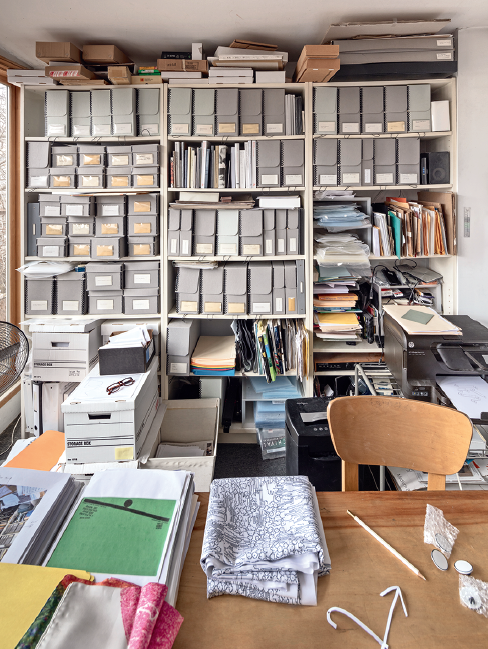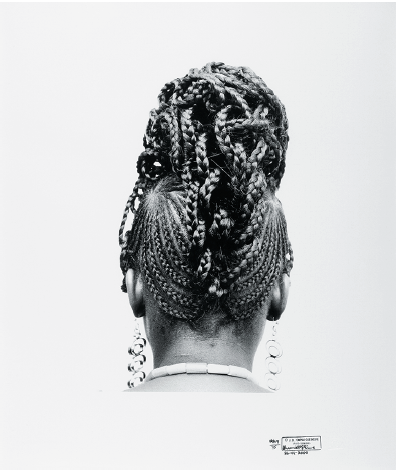Momenta: Biennale de l’image
Photography’s tumultuous relationship with an invisible and extravagant Outside is the abiding, if often subterranean, theme of Momenta: Biennale de l’image, the latest edition of what was previously known as Le Mois de la Photo, Montreal’s enduring photography extravaganza. This current expansive photography festival features 38 artists from 17 countries in a host of venues, anchored at Galerie de l’UQAM and VOX, Centre de l’image contemporaine, with satellite outposts across the city.
Highlights included Luis Arturo Aguirre at the Galerie de L’UQAM, Taryn Simon at the Musée d’art contemporain, Zanele Muholi’s South African LGBTI portraits at Centre Clark, Meryl McMaster’s performative photography at the Musée des beaux-arts de Montréal, Erin Shirreff at Darling Foundry and Terrance Houle at VOX.
The main exhibition(s) at Galerie de l’UQAM and VOX, Centre de l’image contemporaine, the event’s headquarters, had as reciprocal axes the abiding tension between seen and unseen and the said and the unsaid that obtains in the creative use of still and animated images. The 23 artists interrogated what curator Ami Barak called the porous boundary between reality and imagination, through complex issues such as identity, territory, history and time.

Micah Lexier, Spot the Difference, detail, 2017. © Micah Lexier. All images courtesy Momenta: Biennale de l’image.
At the Galerie de L’UQAM, the French artist Adel Abdessemed focused on the image as the story of a disappearance, the seizure of a moment in time that ignites like a spark and is then extinguished. The juxtaposition of his work with that of Luis Arturo Aguirre (Mexico), whose photographs explore with bold and brilliant clarity the ambiguous identity of Mexico’s transvestites and transgendered people—their feminized guises and taut masculine torsos dominating—was both audacious and breathtaking.
Korean artist Seung Woo Back’s enlivening fictions around architectural forms that denounce political propaganda continued a political thread running through much of the exhibited work. Yto Barrada (Morocco) played on the tension between fiction and reality in her use of scenes from a Moroccan database of ’50s and ’60s home movies with an implicit critique of hand-me-down colonial culture. The Croation artist Dora Budor offered compelling portraits of a prematurely aged fashion model— skilfully transformed by Hollywood makeup artists at the photographer’s behest—that address existential and taboo questions related to the passage of time, while LaToya Ruby Frazier (United States) brilliantly questioned where the line is drawn between the self-portrait and mockumentary. Nelson Henricks’s thematic treatment of male bodies as eroticized objects of desire was instructively juxtaposed with Nadia Myre’s photographic translations of scar designs rendered in Algonquin beadwork, with its powerful invocation of the physical and emotional scarring of Indigenous women in colonial society.

JD ‘Okhai Ojeikere, Abebe, 1975, from the series “Hairstyles.” © JD ‘Okhai Ojeikere.
France’s Camille Henrot’s experimental film questioning the loss of authenticity within cultural rituals staged for tourists—footage of adolescents leaping into the void with feet secured by vines—dovetailed nicely with Risa Horowitz’s natureshot images interrogating Ontario and Saskatchewan landscapes that had been impacted thoroughly by the ravages of colonization.
At VOX, the Cameroon artist of advanced political critique in selfportraits that pose him in the guise of black heroes such as Martin Luther King and Angela Davis, effectively subverting the very notion of the self-portrait, while Terrance Houle, an artist of Ojibway and Blackfoot lineage, exposed with commendable irony salient stereotypes concerning the notion of otherness in postcolonial societies, pointing outside the frame by photographing himself inside it—shopping for supermarket produce in his ceremonial Kainai First Nation regalia.
Pascal Grandmaison’s projections of the previously unseen interior mechanisms of an Éclair NPR film camera were less a latter-day experiment in Vorticist aesthetics than a subtle invocation of nationalism, given that Éclair was a key tool in Quebec’s development of cinéma vérité and feature film. These are steampunk abstracts undreamt of by Dziga Vertov. Chinese artist Liu Yue points to the invisible as a fellow traveller of Sugimoto, but with spectral surprise, calling into question our perception of quotidian things through a quixotic magical plenum that exists outside them. Moshe Ninio (Israel) also calls forth ghosts by superimposing two photographs of the glass cage occupied by Nazi war criminal Adolf Eichmann in his trial in Jerusalem in 1961–62. The elision induced a frisson that literally raised the hairs on the nape of my neck. One of the great unforeseen gifts of Momenta was JD ‘Okhai Ojeikere’s work (Nigeria)—a stunning inventory of approximately 1,000 Nigerian hairstyles documented in intense photos over the course of the last four decades. Kim Waldron (with tongue presumably held firmly in cheek) documented the funding of her new offshore enterprise based in Hong Kong, opening an unusual window on power relations in what could be interpreted as a cover story for the infiltration of a covert agent.

Zanele Muholi, Somnyama IV, Oslo, 2015, from the series “Somnyama Ngonyama.” © Zanele Muholi.
One of the strongest and most uncompromising inclusions in Momenta was Zanele Muholi, at Centre Clark, whose powerful portraits, inspired by her own experience, effectively defended and definitively unveiled the visual history of the LGBTI community. These works are characterized by a lucid, even hallucinatory, clarity. Their extraordinary resonance suggests an artist working at the height of her powers, and the images have the force of real reparative critique, boldly calling down racism and exploding the myriad vapid stereotypes of how the Black body has been historically represented.
Korean artist Jin-me Yoon at Galerie B-312, in Other Hauntings; A Geography Beloved (Song) and Other Hauntings; A Geography Beloved (Dance) (both 2016), offers a thematic investigation of the consequences of the South Korean government’s building a naval base at Gangjeong, a village situated on the volcanic island of Jeju. The artist identifies the villagers as poetic figures of resistance in a struggle to retain a vanishing quality of life. She points to the unseen world of vital presences displaced and upset by this incursion, in what is a terrifically moving disquisition on place and identity.
At the Montreal Museum of Fine Arts, Meryl McMaster employed, in self-reflexive fashion, a full retinue of accessories—clothes, necklaces, talismans and so forth—that become prosthetic extensions of the body. In the works exhibited, the artist— who is Plains Cree and a member of the Siksika Nation on her father’s side and Euro-Canadian (British and Dutch) on her mother’s side— explores First Nations’ identity and attendant issues with great acuity in a performative manner. Notions of duality, nomadism, bicultural identity and the intertwining of cultural histories move to the foreground of these works with poetic resonance.
Taryn Simon, in a Momenta exhibition realized in collaboration with the Musée d’art contemporain de Montréal, essayed a splendid taxonomy in her pursuit of imbricated issues of security, religion, politics, science and nature. Paperwork and the Will of Capital, 2015, is comprised of a dozen sculptures and 36 photographs of decorative floral displays that prominently adorned the tables at the signings of major international treaties, involving the nations present at the United Nations Monetary and Financial Conference at Bretton Woods in 1944. Texts explaining the political and economic contexts of the documents are instantiated in the frames. The meticulously composed photographs of the bouquets, together with their stories, offer a potent listing of power relations that also saliently and mischievously reference the floral bouquets of Jan van Huysum (1682–1749), perhaps the most revered Dutch still-life painter of the 18th century.

Luis Arturo Aguirre, Phoebe, 2011, from the series “Desvestidas.” © Luis Arturo Aguirre. lly
At Dazibao, Akram Zaatari looked critically at the history of postwar Lebanon and examined media accounts of political conflicts. The video installation Letter to a Refusing Pilot, 2013, takes a cue from Letters to a German Friend, 1943–45, by Albert Camus, and focuses on the refusal of an Israeli pilot to bomb a public school in Saida, acknowledging the humanity of the pilot. At Occurrence, David Hartt explored with thematic integrity and a certain formal elegance the history and political evolution of urban contexts. Filmed via drone, The Last Poet, 2017, presents a journey from Boston to Atlanta, narrated by philosopher and economist Francis Fukuyama, who disarmingly discusses drone technology. Also at Occurrence, Anne-Marie Proulx examines the presence of the human trace in the landscape while creating hybrid landscapes that do not in fact exist.
At Optica, Valérie Mréjen’s moving and still images, inspired by sundry personal memories, notions and misunderstandings, were both moving and jarring. In Leur histoire, 2014, two people seated at a restaurant table engage in a dialogue punctuated by images, imported from elsewhere, that neither stabilize nor destabilize the proceedings. One of France’s great actresses, Irene Jacob, is one of the people. Also at Optica, Melik Ohanian presents, to hypnotic effect, portraits of time itself.
At the Darling Foundry, Erin Shirreff ’s double projection Concrete Buildings, 2013–16, considers two prototype buildings that the American artist Donald Judd designed and built in Marfa, Texas. A potent phenomenology—a post-material ghost, if you will— slowly emerged from this video installation’s long-duration montages. One of her finest works to date, the installation was a brilliant latter-day reinvention and subversion of Michael Snow’s masterwork Wavelength, 1967. At the McCord Museum, Jayce Salloum offered a cornucopia of images that seemed to mark the way stations of an itinerant traveller and ethnographer of the near and the far, the images welling up from the collective unconscious like numinous signposts beyond the pale.

Jin-me Yoon, Other Hauntings: A Geography Beloved (Dance), 2016. © Jin-me Yoon.
Some of the most arresting work in Momenta was featured in the satellite exhibitions. For instance, Natascha Niederstrass’s Le point aveugle at Galerie Trois Points offered viewers an anfractuous labyrinth fraught with arresting images and objects. Niederstrass took sundry images in the Recoleta Cemetery in Buenos Aires, which were hauntingly funereal. The spectral presences that emanated from their surfaces made hers a singularly memorable show.
It is the voluptuous eye, as the philosopher Alphonso Lingis once put it, that rules here: the voluptuous eye that moves restlessly across the surface of things, caressing and caressed by the skin of the visible. “Can we, spacemen, still be said to live in a world?” Lingis’s question is not rhetorical but rhapsodically instructive when asked of the works exhibited here, for as I moved through the many exhibition halls in which the works of the Momenta artists were mounted, I understood that the worlds depicted were not simply about aggregations of things seen, however diverting, but a lifeworld, a whole human cosmos, laid out in Proustian fashion, as Lingis said, according to axes of close and far, intimate and alien, upwards and downwards, lofty and base. While it is true that the human world cannot be perceived or manipulated as things can, the eye of these photographers sought out the invisible with aggressiveness and resolve, seizing on the alien look of the Other so that we could make it our own. Momenta convinced us that it is not only painting that is a snare for the eye, but the photographic image as well.
Momenta, the exhibition, is accompanied by an excellent catalogue. Co-produced with the prestigious publishing house Kerber Verlag, it brings together texts by the curator and five authors— Mara Ambrožiˇc, Mirna Boyadjian, Françoise Docquiert, Sophie Hackett and Bénédicte Ramade—who collectively address the question, “What Does the Image Stand For?” Noted artist Micah Lexier also created a photographic project, Spot the Difference, 2017, a series of eight seemingly identical images that, upon closer examination, reveal individual differentiating details, done especially for the book. This in situ bookwork, with its initially unseen differences, is a lovely rubric under which all the works in Momenta may be meaningfully subsumed. ❚
Momenta: Biennale de l’image 2017 was exhibited at various venues in Montreal from September 7 to October 15, 2017.
James D Campbell is a writer and curator in Montreal, and is a frequent contributor to Border Crossings.

